Garden Flowers
Issue date: 18th April 2024
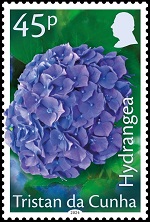 |
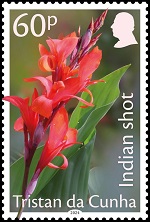 |
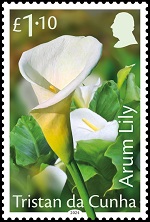 |
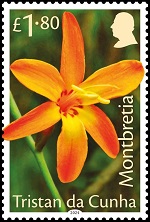 |
| 202401 | Mint Stamps (45p, 60p, £1.10, £1.80) | £3.95 |
| 202402 | First Day Cover (with 45p, 60p, £1.10, £1.80 stamps) | £5.15 |
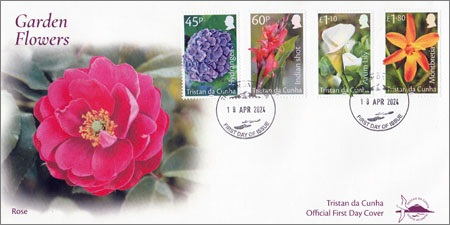
On Tristan da Cunha there are many garden flowers that have been introduced over the years. There is no Garden Centre where one can purchase plants so everything is either grown from seed or cuttings. Islanders share young plants they have grown from their garden with each other whilst many seeds are bought from South Africa and the UK.
Some of the garden flowers that were brought in as ornamentals have now dispersed into the wild. These flowers now growing around the settlement are free for everyone to enjoy.
Description of Stamps
45p Hydrangea: The vibrant pom-poms of hydrangeas are unmistakeable and with over 75 species they are one of the most beautiful flowers in the world.
Although hydrangeas were first cultivated in Japan, fossils found in North America show that they arrived there 40 to 65 million years ago. They reached Europe much later in 1736.
Their name comes from the Greek "Hydor" (water) and "angos" (jar or vessel), emphasizing the need to water the plant often, although they don’t like being over-watered.
The variety of colours are determined by the pH of the soil, so a mixed pH can result in a variety of different colours. However, despite these vibrant colours, most hydrangeas are fragrance-free.
60p Indian Shot: Commonly known as Indian shot, African arrowroot, purple arrowroot, and many other names, it was called Canna indica by Linnaeus in his work 'Species Plantarum'. In fact, Canna indica is the first plant named in the book, so it could be seen as the first life form to receive a valid binomial name.
Despite its various names, the species is actually a native of the Americas, especially South America. The subterranean rhizomes of the Indian shot are edible and were a food crop cultivated by the original inhabitants of the Americas. The seeds, which are small, globular, and black, are very hard and dense and can even be used as bullets, hence the name Indian shot.
£1.10 Arum Lily: The Arum Lily has cultural significance in various parts of the world. In South Africa, it is a symbol of purity and is often used in bridal bouquets. It is also used as a symbol of peace and hope. In Christianity, the Arum Lily represents the resurrection of Jesus Christ and is often used during Easter services.
The Arum Lily is not a true lily. It belongs to the Araceae family, which also includes other popular houseplants like the Peace Lily and Philodendron. It is a beautiful and versatile plant with a rich cultural history. Its unique appearance and easy-to-grow nature make it a popular choice for gardens and floral arrangements. It is native to South Africa but is now widely cultivated in other parts of the world.
The plant's spathe and spadix are actually modified leaves that work together to attract pollinators. The spadix produces heat, which helps to release the plant's scent and attract insects like beetles and flies.
The Arum Lily is toxic to humans and pets. The plant contains calcium oxalate crystals, which can cause skin irritation, swelling, and even respiratory issues if ingested. However, the plant's rhizomes are edible and have been used as a food source in parts of Africa for centuries. They can be boiled or roasted and eaten like potatoes.
£1.80 Montbretia: Montbretia, is a stunning flowering plant that belongs to the iris family. It is native to parts of Africa, including South Africa, and comprises more than 400 different species.
The flowers are known for their vibrant colours and eye-catching displays. They typically bloom in shades of red, orange, and yellow, adding a burst of colour to gardens and attracting pollinators like bees and butterflies.
Paired with the showy flowers, their long, sword-shaped leaves add an interesting textural element to gardens.
Montbretia is a low maintenance, hardy and adaptable plant that is a wonderful addition to any garden.
FDC Cover: Rose This local wild Rose was introduced by an islander, many years ago. It is one of the Rose species with small, double flowers. Unlike some of the other Rose species this one does not produce fruit.
Technical Specifications
| Designer: | Andrew Robinson | Printer: | Cartor |
| Stamp size: | 28 x 42mm | Perforation: | 13¼ x 13½ per 2cms |
| Process: | Lithography | Sheet Layout: | 10 |
| Production Co-ordination: | Creative Direction (Worldwide) Ltd | ||
